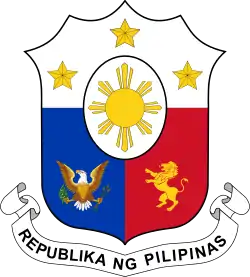Argentina–Philippines relations
Argentina–Philippines relations refers to the diplomatic relations between the Argentine Republic and the Republic of the Philippines. Both nations are members of the Association of Academies of the Spanish Language, Group of 77, the G20 developing nations, and Forum of East Asia-Latin America Cooperation and the United Nations.
 | |
Argentina |
Philippines |
|---|---|
Country comparison
History
Both Argentina and the Philippines share a common history in the fact that both nations were once part of the Spanish Empire. During the Spanish colonial period, Argentina was then part of the Viceroyalty of the Río de la Plata and administered from Buenos Aires while the Philippines was governed from the Viceroyalty of New Spain in Mexico City. Diplomatic relations between Argentina and the Philippines began on 27 August 1948. In April 1949, the Philippines opened a diplomatic legation in Buenos Aires.[1] In May 1960, both nations diplomatic legations were elevated to the rank of embassy.
In July 1986, President Raúl Alfonsín became the first Argentine head of state to visit the Philippines. In October 1995, Argentine President Carlos Menem also paid a visit to the Philippines.[1] In September 1999, Philippine President, Joseph Estrada, paid a state visit to Argentina, becoming the first Philippine head-of-state to visit the South American nation.[1]
In September 2012, Argentine Foreign Minister, Hector Timerman, paid a visit to the Philippines and met with President Benigno Aquino III to discuss the broadening of the two countries’ relations and possible people and cultural engagements.[2] In February 2014, both nations held the 2nd Bilateral Consultation Meeting in Manila where they agreed to further enhance bilateral trade relations.[3]
In 2018, both nations celebrated 70 years of diplomatic relations.[4]
High-level visits

High-level visits from Argentina to the Philippines
- President Raúl Alfonsín (1986)
- President Carlos Menem (1995)
- Foreign Minister Hector Timerman (2012)
High-level visits from the Philippines to Argentina
- President Joseph Estrada (1999)
- Foreign Secretary Albert del Rosario (2011)
Bilateral relations

Both nations have signed several agreements such as an Agreement establishing Diplomatic Relations (1948); Agreement to elevate both nations diplomatic representations to the rank of embassy (1960); Treaty of Friendship and Cultural Relations (1965); Commercial Agreement (1988); Memorandum of Understanding to promote Trade in Agricultural matters (1995); Agreement on the Suppression of visas for Holders of Diplomatic and Official Passports (1999); Agreement on the Reciprocal Promotion and Protection of Investments (1999); Agreement for the Establishment of a Mechanism for Bilateral Consultations between both nations Ministry's of Foreign Relations (2005); and a Memorandum of Understanding between the Foreign Service Institute of the Philippines and the Institute of Foreign Service of the Argentine Nation (2011).[1]
Resident diplomatic missions
- Argentina has an embassy in Manila.[5]
- Philippines has an embassy in Buenos Aires.[6]



